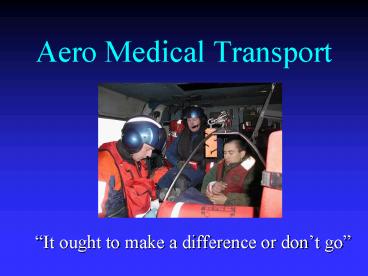Aero Medical Transport - PowerPoint PPT Presentation
1 / 35
Title:
Aero Medical Transport
Description:
Aero Medical Evacuation is faster than ground or surface platform ... Treatment of acetaminophen overdose can wait 12 to 18 hours. Few OD cases require dialysis ... – PowerPoint PPT presentation
Number of Views:87
Avg rating:3.0/5.0
Title: Aero Medical Transport
1
Aero Medical Transport
- It ought to make a difference or dont go
2
Ken Harman M.D.CAPT, FS, USPHS USCG Aviation
Training CenterMobile, AL
3
Objectives
- Review Aero Medical Evacuation
- Discuss Risk Management Issues
- Define the role of the Coast Guard Flight Surgeon
- Discuss Best Practices approach
4
Aero Medical Evacuation
- Using an aviation asset to move an ill or
injured person to a higher level of care.
5
Aero Medical Evacuation Assumptions
- Aero Medical Evacuation is faster than ground or
surface platform transport - In-flight interventions and earlier definitive
treatment saves lives - Aviation safety rules and regulations make these
missions safe
6
Agencies Prosecuting Aero Medical Missions
- Civilian - Competitive multi-billion dollar
industry in most western nations - DoD Active Duty, National Guard and Reserve
Components - USCG About 1,100 Maritime and non-Maritime
cases annually
7
Civilian air ambulance crashes have increased in
recent years
The Grand Rapids Press, May 29, 2008
8
National Transportation Safety Board (NTSB)
Statistics
- 14 air ambulance crashes in 2007, with 24 deaths
- 13 air ambulance crashes in 2006, with 10 deaths
- 61 air ambulance crashes between 2000 and 2006,
with 54 deaths
9
Causes of Civilian Air Ambulance Mishaps
- Unplanned flight into instrument meteorological
conditions (IMC) - Influence of the mission on pilot judgment
- Competitive pressures to fly
- Pilot proficiency
- Pilot fatigue
10
Houston, we have a problem..
- "We've been struggling with these issues for as
long as I've been in this business. The reasons
we were having accidents 25 years ago are still
the same reasons we're having accidents today." - May 2007 Denver Post interview with Ed
Stockhausen, Air Methods' director of safety.
11
(No Transcript)
12
USCG Aero Medical Transport Mission
- Emergency transport only.
- Carrier of last resort.
- To save life or limb and alleviate suffering.
13
Operational Risk Management
- The net sum of mission risk and mission gain.
- Aircraft Commanders and Operations Officers are
the experts in the risk assessment. - Flight Surgeons are the experts in the gain
assessment.
14
Operational Risk Management
- The Flight Surgeon must provide specific, cogent
and medically sound advice to the operations
personnel. - The data used to formulate this advice will be
incomplete, inaccurate or both.
15
5 POINTS
- What do they have?
- What do they need?
- When do they need it?
- Where can they get it?
- Can we meet the window of opportunity?
16
(No Transcript)
17
Key Flight Surgeon Decision Elements
- Aero Medical Evacuation recommended?
- What is the gain life, limb or alleviation of
suffering? - How soon? Give an exact number of hours!
- Where do they need to go?
18
Key Flight Surgeon Decision Elements
- Test What treatment will be immediately
provided at the destination that is reasonably
certain to favorably affect the outcome?
19
FREQUENT SCENARIOS
- CPR IN PROGRESS
- CHEST PAIN/ ACUTE MI
- STROKE
- SEIZURE
- ABDOMINAL PAIN
- OVERDOSE
- CHF
- TRAUMA
20
CPR IN PROGRESS
- No survival after 10 minutes.
- Response time is too late to realistically expect
to save a life. - All that remains is risk.
21
CHEST PAIN
- How soon?
- When is too late?
- What can you do?
- lt 4 hours from onset
- gt12 hours (ACLS)
- Aspirin, oxygen, rest
22
STROKE
- How soon?
- What treatment?
- lt 3 hours from onset (ACLS)
- Thrombolytic therapy
23
(No Transcript)
24
SEIZURES
- When new in onset, associated with trauma or
fever - A history of seizures reduces emergent risk
- NPO, recovery position, nothing in the mouth.
- When is it an emergency?
- What can you do?
25
(No Transcript)
26
ABDOMINAL PAIN
- 40 discharged from ED without a diagnosis
- Most abdominal pain can wait 12 hours
- More dangerous if passing blood or associated
with fever - Remember ectopic pregnancy!
- Age gt 65 increases risk of vascular catastrophe
27
OVERDOSE
- Most OD cases need only supportive care
- Treatment of acetaminophen overdose can wait 12
to 18 hours - Few OD cases require dialysis
28
CHF
- Treatments?
- Why MEDEVAC?
- Diuretics, nitro, oxygen, digoxin and afterload
reduction (ACE inhibitors) - Aortic assist pumps or transplant.
29
(No Transcript)
30
TRAUMA
- Fractures, closed
- Fractures, open
- Amputations
- Falls from higher than your own height
- 7 days
- lt 6 hours reduces infection risk (ATLS)
- lt 6 hours (ATLS
- Carry increased risk of serious injury
31
TRAUMA
- Burns, partial thickness
- Burns, full
- thickness
- gt 20 Body Surface Area (BSA) needs referral to
burn center - gt 10 BSA for age lt 10 or age gt 50 needs burn
center referral - gt 5 any age needs a burn center (ATLS)
32
(No Transcript)
33
ALTITUDE RESTRICTIONS
- lt 1000 FEET ASL unless aircraft can pressurize to
sea level
- CLOSED HEAD INJURY
- INTESTINAL OBSTRUCTION
- SCUBA DIVING EMERGENCY
- PNEUMOTHORAX
34
CAVEATS
- AS SOON AS POSSIBLE
- WHAT IF THEY GET WORSE?
- THEYRE GOING INTO SHOCK
35
QUESTIONS ?































